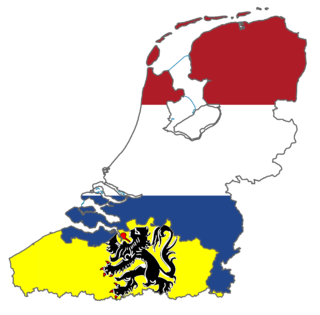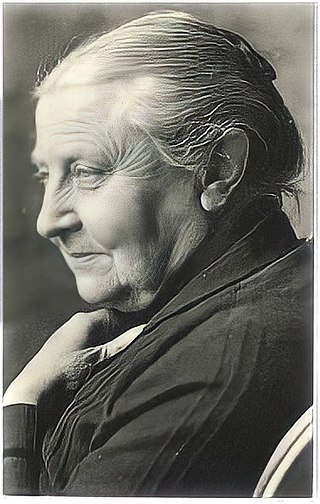
Greater Netherlands is an irredentist concept which unites the Netherlands, Flanders, and sometimes Brussels. Additionally, a Greater Netherlands state may include the annexation of the French Westhoek, Suriname, formerly Dutch-speaking areas of Germany and France, or even the ethnically Dutch and/or Afrikaans-speaking parts of South Africa, though such variants are mostly limited to far-right groups. A related proposal is the Pan-Netherlands concept, which includes Wallonia and potentially also Luxembourg.

The Vlaamsch Nationaal Verbond, widely known by its acronym VNV, was a Flemish nationalist political party active in Belgium between 1933 and 1945. It became the leading force of political collaboration in Flanders during the German occupation of Belgium in World War II. Authoritarian by inclination, the party advocated the creation of a "Greater Netherlands" (Dietsland) combining Flanders and the Netherlands.

The Senate is one of the two chambers of the bicameral Federal Parliament of Belgium, the other being the Chamber of Representatives. It is considered to be the "upper house" of the Federal Parliament. Created in 1831 as a chamber fully equal to the Chamber of Representatives, it has undergone several reforms in the past, most notably in 1993 and 2014. The 2014 elections were the first without a direct election of senators. Instead, the new Senate is composed of members of community and regional parliaments and co-opted members. It is a chamber of the communities and regions and serves as a platform for discussion and reflection about matters between these federated entities. The Senate today plays a minor role in the federal legislative process. However, the Senate, together with the Chamber, has full competence for the Constitution and legislation on the organization and functioning of the Federal State and the federated entities. Since the reform of 2014, it holds about ten plenary sessions a year.
The Belgian Holocaust denial law, passed on 23 March 1995, bans public Holocaust denial. Specifically, the law makes it illegal to publicly "deny, play down, justify or approve of the genocide committed by the German National Socialist regime during the Second World War". Prosecution is led by the Belgian Centre for Equal Opportunities. The offense is punishable by imprisonment of up to one year and fines of up to 2,500 EUR.

Verdinaso, sometimes rendered as Dinaso, was a small fascist political movement active in Belgium and, to a lesser extent, the Netherlands between 1931 and 1941.

The Party for the Animals is a political party in the Netherlands. Among its main goals are animal rights and animal welfare.

Wies Moens was a Belgian literary historian, poet and Flamingant activist. He was also a founding member of the right-wing Verdinaso movement.

Schoorl transit camp, originally a Dutch army camp (1939–1940), was a Nazi concentration camp (1940–1941) near the village of Schoorl in the Netherlands.

Johannes Theodorus Furstner was a Dutch naval officer and politician. Reaching the rank of lieutenant admiral, he served as Minister of the Navy during World War II in the Second Gerbrandy cabinet.

Wilhelmina Drucker was a Dutch politician and writer. One of the first Dutch feminists, she was also known under her pseudonyms Gipsy, Gitano, and E. Prezcier.

The Weerbaarheidsafdeling was the paramilitary arm of the National Socialist Movement in the Netherlands (NSB), the fascist political party that collaborated with the German occupiers of the Netherlands during World War II. The organization, roughly equivalent to the German SA, was founded in 1932 by Anton Mussert, co-founder of the NSB in 1931 and its leader until the end of the war. Members wore and marched in black uniforms and were thus called "blackshirts". In 1933 the Dutch government banned the wearing of uniforms, and the WA was disbanded in 1935 in order to forestall the Dutch government's banning it. In 1940, after the German invasion, the WA became openly active again, and more ruthless than before. They specialized in violent attacks, particularly on the Dutch Jewish population.

Marie-Elisabeth Belpaire was a Belgian writer and activist. She was known as the "mother of the Flemish Movement".

The Special Forestry Platoon, nicknamed the woodchoppers of the Orne, was a non-combat penal military unit of the Belgian Army during World War I. As its name suggests, the unit specialized in forestry, specifically woodchopping, conducted as a form of penal labour.
Emilie Maria Claeys was a Belgian feminist and socialist.

Zanddijk is a neighbourhood of Veere and former village in the municipality of Veere, Zeeland, Netherlands.
Anarchism in the Netherlands originated in the second half of the 19th century. Its roots lay in the radical and revolutionary ideologies of the labor movement, in anti-authoritarian socialism, the free thinkers and in numerous associations and organizations striving for a libertarian form of society. During the First World War, individuals and groups of syndicalists and anarchists of various currents worked together for conscientious objection and against government policies. The common resistance was directed against imperialism and militarism.

The Netherlands Armed Forces in Suriname was the military force maintained by the Kingdom of the Netherlands in its colony of Suriname, in the area that is now independent Republic of Suriname.
The Flemish Guard was a collaborationist paramilitary formation which served as an auxiliary police in parts of German-occupied Belgium during World War II. It was founded as an independent formation in May 1941 at the initiative of the Union of Flemish Veterans and the Flemish National League. Both associated with the pre-war Flemish Movement, the VNV soon emerged as the largest collaborationist faction in Flanders during the occupation. In propaganda, the Flemish Guard was depicted as the police force of a future independent Flanders. It was distinct from the Flemish Legion, formed by the VNV in July 1941, to participate in the German invasion of the Soviet Union.
The Network of War Collections is a partnership of over 250 archival institutions, museums, remembrance centers and libraries in the Kingdom of the Netherlands, the former Dutch colonial empire, and internationally to bring together scattered collections of resources pertaining to World War II. The network is financed by the Ministry of Health, Welfare and Sport and receives a contribution from the National Fund for Peace, Freedom and Veteran Care.
Rita Mulier is a Belgian feminist author and economist. Writing for De nieuwe maand, she set up the Vrouwen Overleg Komitee and played a role in the women's liberation movement in Belgium. She focused on mother's rights in the workplace and held a post in the Flemish Community from 1991 until 1996. She was recognised with a baronetcy and published her autobiography in 1999.














